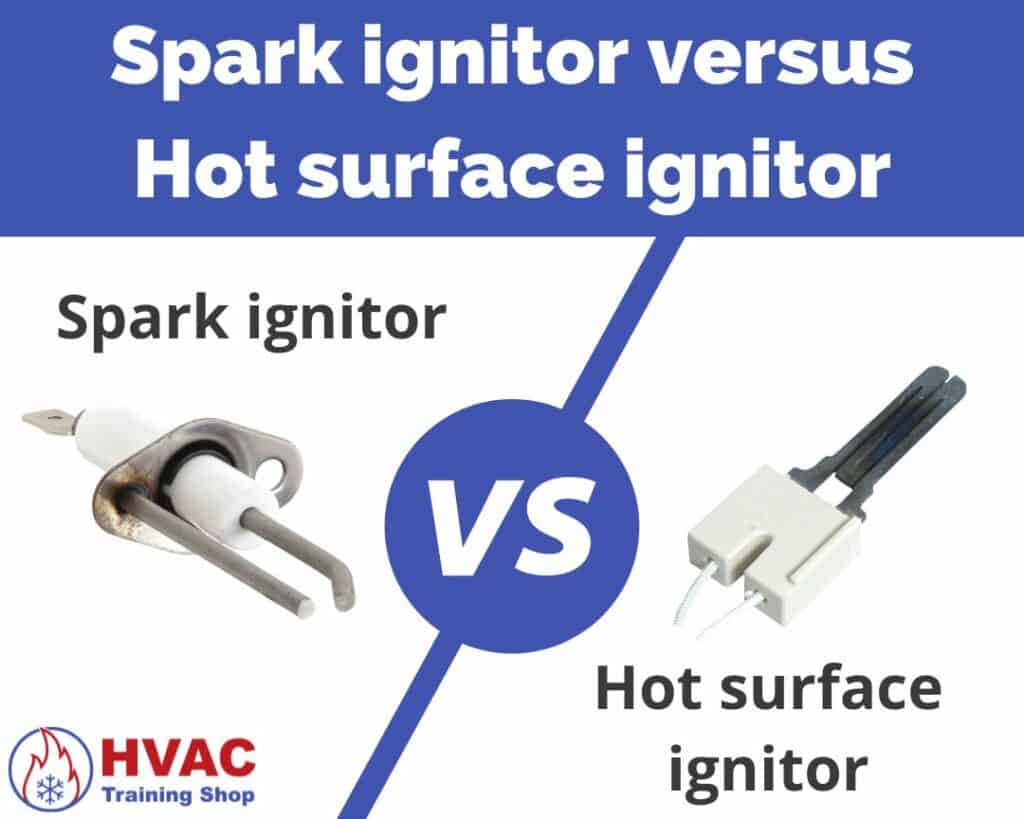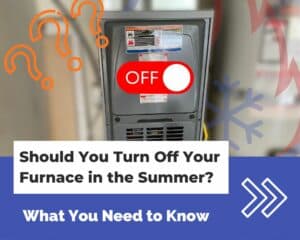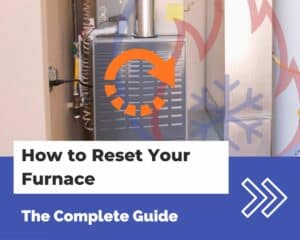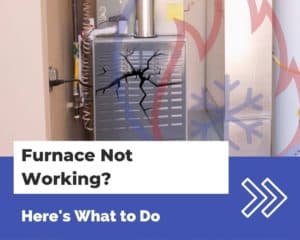HVAC Training Shop is reader-supported. As an Amazon Associate, I earn from qualifying purchases.
Your furnace just turned on, but it’s making a strange noise—what do you do?
Furnaces make all sorts of noises—from buzzing to whistling. But some are normal and some aren’t.
In this article, I’ll go over all the different types of noises that a furnace makes and what they mean. I’ll also go over what you should do if you hear a noise coming from your furnace.
Here are the different noises that a furnace makes and their causes:
- Humming or buzzing – Bad blower motor, bad inducer motor, bad capacitor, bad transformer, or loose parts.
- Whistling – Dirty air filter or air leak.
- Whining – Bad blower motor, bad inducer motor, or dirty burners.
- Squealing – Fan belt needs adjustment, bad blower motor bearings, or bad blower fan bearings.
- Clicking – Flame sensor needs cleaning or replacement, bad gas valve, crack in the heat exchanger, bad blower motor, or bad inducer motor.
- Gurgling – Clogged condensate drain, exhaust pipe flooded, or inducer motor flooded
Furnace is making a humming or buzzing noise
Humming and buzzing noises usually indicate the fault of an electrical component in a furnace.
A bad motor or capacitor can cause a furnace to make a humming noise.
Buzzing noises are also caused by loose parts in your furnace vibrating around.
Here are some possible causes of furnace humming and buzzing noises:
- Bad capacitor. If the blower motor capacitor is bad, then the blower motor won’t start. Instead, the blower motor will stay in place and produce a humming noise instead.
Check out my article that covers what you should do if you think your blower motor’s capacitor is bad. - Bad blower motor. A bad blower motor is one of the most common sources of humming noises in a furnace. If you hear a humming noise coming from the blower motor and it’s not spinning, check the capacitor first. If the capacitor is good, the start winding of the blower motor could be burned out.
- Bad inducer motor. A failed inducer motor will sometimes produce a humming noise when your furnace turns on. If the inducer motor is bad, it will need to be replaced.
- Bad transformer. The transformer in a furnace will sometimes make a loud humming noise. The humming noise from a transformer is caused by the de-lamination of the layers in the transformer. A transformer will sometimes still work when it’s humming, but it should be replaced since it’s going bad.
- Loose internal parts. It’s possible that there’s a loose component in your furnace that makes a humming noise when your furnace is running. All of the bolts need to be tight to keep your furnace’s internals secure.
- Loose ductwork. The ductwork that delivers air throughout your home is made of a series of interconnected pieces of sheet metal. Over time, the joints and seams between the individual duct pieces can wear out and rub up against each other. The vibrations from your running furnace can make the ductwork hum.
Furnace is whistling
Whistling noises from a furnace are almost always caused by a dirty air filter or an air leak. The whistling noise happens when air rushes across or through a component.
Here are some common causes of whistling noises from a furnace:
- Dirty air filter. If your furnace is whistling, the first thing you should check is your furnace’s air filter. A dirty air filter will cause airflow restrictions in your furnace system. Airflow restriction can cause whistling in your furnace system.
- Air leak. Air leaks in your furnace’s panels or ductwork will emit a whistling noise when your furnace runs. The whistling noise happens when air rushes through a hole somewhere in the furnace system.
To fix an air leak, you need to first find the source of the air leak. Look for holes in the seams of the ductwork or a gap in the furnace’s cover panels. Next, stop the air leak.
If the air leak is coming from a seam on the furnace’s cover panels, you may be able to shift the panel to stop the leak.
If the air leak is coming from a hole in the ductwork, use aluminum foil tape to seal the hole.
This scrim-backed aluminum foil tape is reinforced, so it won’t tear easily after its applied. This means that it will keep your ducts sealed for years to come.
Furnace is whining
High-pitched whining noises usually stem from the furnace’s blower, inducer, or burners.
Keep in mind that high-pitched whining noises are completely normal in some furnaces.
However, if your furnace is making a whining noise when it usually doesn’t, you have an issue.
Furnace whining noises are usually caused by one of the following:
- Blower motor. The blower motor can sometimes emit a high-pitched whine when it runs. The high-pitched whine comes from the blower motor’s bearings when it’s spinning. If your blower motor is producing a high-pitched whine, then there’s a good chance that the bearings need to be oiled or replaced.
- Inducer motor. The inducer motor in your furnace spins at a high RPM, so it will sometimes emit a whining noise when it wears down. If your furnace’s inducer is whining, then its bearings may need to be oiled.
- Burners. The burners in your furnace will emit a high-pitched whine when they get dirty. Build-up in the burners will cause the burners to make a whining noise when they light up. The whining noise comes from the vibrations of the burners when gas flows through them. If your burners are whining, then they need to be cleaned out.
Furnace is squealing
Squealing noises from a furnace are almost always due to blower issues. If you have an older furnace, the blower’s fan belt is the most likely cause of squealing noises.
Most newer furnaces have direct-drive blower motors, so they don’t have a fan belt.
If you have a direct-drive blower in your furnace, then the squealing noises could be coming from the blower motor’s bearings.
- Blower fan belt. If your furnace squeals loudly when starting up, then the blower’s fan belt is likely to blame. Most older furnaces use belt-driven blowers that need a fan belt to run. The fan belt will slide around and squeal loudly when the blower motor starts up.
If the blower fan belt is squealing, then the belt needs to be tensioned properly so it doesn’t slide around when the blower motor turns on. - Blower motor bearings. Blower motor bearings will begin to squeal if they need oil or are wearing out. If your blower motor’s bearings are squealing, then try oiling them first. If the squealing doesn’t stop, the blower motor may need to be replaced.
- Blower fan bearings. If you have an older furnace with a belt-driven blower, then the blower fan itself has bearings that can squeal. If your blower’s bearings are squealing, then they need to be oiled or replaced.
Furnace is making a clicking noise
Older gas furnaces have a spark ignitor that makes a clicking noise when it turns on. The clicking noise comes from the sparking of the ignitor when it lights the gas burners.
If you have an older furnace making a clicking noise, there’s a good chance that it’s the spark ignitor.
However, if you have a newer furnace with a hot surface ignitor, then the clicking noise is coming from elsewhere.
If you’re not sure if your furnace has a spark ignitor or hot surface ignitor, check out the comparison below:

Here are a few things that can cause your furnace to make a clicking noise:
- Bad flame sensor. If you have an older furnace with a spark ignitor, the spark ignitor will make clicking noises when the furnace starts up. The clicking noises are caused by the ignitor sparking.
If the flame sensor is bad, then the furnace thinks that the gas isn’t igniting. This causes the ignitor to repeatedly try to ignite the gas, causing the clicking noise. If the flame sensor isn’t working, then it should be cleaned or replaced. - Bad gas valve. If the furnace’s gas valve is not opening, then the spark ignitor will repeatedly click to try and ignite the gas burners. If the gas valve is bad, then it needs to be replaced.
- Heat exchanger expanding/contracting. The furnace’s heat exchanger will sometimes emit clicking noises as it expands or contracts. If the heat exchanger is cracked, then the clicking noises will become noticeably louder. If your furnace’s heat exchanger is making loud clicking noises, shut off your furnace and call a local HVAC professional.
- Bad blower motor bearings. The furnace’s blower motor bearings may emit a clicking noise when they need oil or are going bad. If there is a clicking noise coming from the blower when your furnace turns on, then this is likely the issue. If the blower motor’s bearings are bad, then they need to be oiled or replaced.
- Inducer motor bearings or buildup. The inducer motor has bearings that may click when going bad. Also, the inducer wheel could have soot build-up or corrosion on it, causing a clicking noise when it spins. If there is a clicking noise coming from your inducer, you can first try oiling and cleaning it out. If oiling and cleaning don’t work, then the inducer needs to be replaced.
Furnace is making a gurgling noise
If your furnace is making a gurgling noise, then it’s most likely coming from the condensate drain pipe.
High efficiency furnaces produce condensate that must be drained out through its condensate drain pipe.
If the condensate drain pipe gets clogged up, your furnace will get backed up with water and make a gurgling sound when it runs.
To clean out a clogged furnace condensate drain pipe, you can usually just take the pipe apart and unclog it by hand. In some cases, you can also employ a wet/dry vacuum to clear out the clog.
Here are some other causes of a furnace making a gurgling noise:
- The exhaust pipe is flooded. The condensate from your high efficiency furnace can sometimes get trapped in the exhaust pipe if the pipe is installed incorrectly.
- The inducer is flooded. In some cases, water from a high efficiency furnace will back up into the induer housing. A flooded inducer will make a gushing sound when your furnace starts up.
- The condensate drain needs to be primed. If you have an AC coil installed in your furnace, it may need to be “primed”, otherwise air will be sucked into your furnace from the drain port. The vacuum in the drain pipe will suck any condensation back into your furnace and make a gurgling sound when your furnace runs.
If you’re hearing a gurgling water sound coming from your furnace, I’ve written an entire article about the issue. You can read it here:




